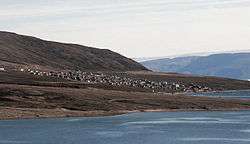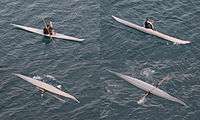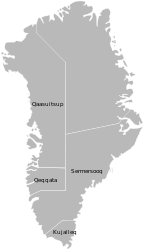Qaanaaq
| Qaanaaq Thule | |
|---|---|
|
Qaanaaq | |
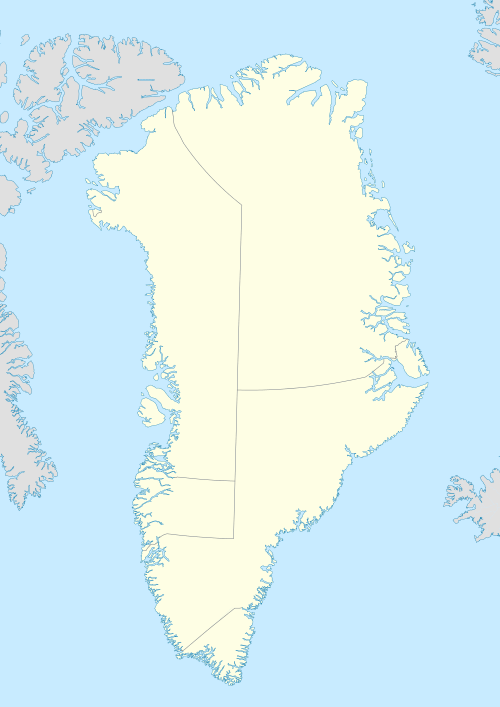 Qaanaaq Location within Greenland | |
| Coordinates: 77°28′00″N 69°13′50″W / 77.46667°N 69.23056°WCoordinates: 77°28′00″N 69°13′50″W / 77.46667°N 69.23056°W | |
| State |
|
| Constituent country |
|
| Municipality |
|
| First settled | 2000 BC |
| Population (2013) | |
| • Total | 656[1] |
| Time zone | UTC-03[2] |
| Postal code | 3971 |
Qaanaaq (IPA: [qɑːnɑːq]), formerly Thule or New Thule, is the main town in the northern part of the Qaasuitsup municipality in northwestern Greenland. It is one of the northernmost towns in the world. The inhabitants of Qaanaaq speak Kalaallisut and Danish and many also speak the Inuktun language. The town has a population of 656 as of 2013.[1]
History
The Qaanaaq area in northern Greenland was first settled around 2000 BC by the Paleo-Eskimo migrating from the Canadian Arctic.[3]
The town of Qaanaaq was established in the winter of 1953 when the United States expanded their airbase at Thule and forcibly relocated the population of Pituffik and Dundas 31 km (19 mi) to the north within four days during the height of the Cold War. The settlement was subsequently moved another 100 kilometers (62 miles) to the north.
Culture
Ways of living so far north and in such severe climatic conditions are passed on from generation to generation, and this ability to adapt has contributed to the survival of this small community. When the sea becomes open sometime around August, large dinghies with powerful engines are used for both hunting trips and ordinary journeys. It is still light twenty-four hours a day at this time - the Midnight Sun lasts from the middle of April to the end of August. Nothing from the hunt goes to waste: the skins are used for clothing and covering the kayaks; the flesh and offal are eaten by humans and domestic animals; the narwhal and walrus tusks are carved into finely-worked figures, jewellery and hunting implements, and even feathers can be used in handicrafts.
Transport
Air Greenland operates fixed-wing aircraft services between Qaanaaq Airport and Upernavik Airport, with further connections to Ilulissat Airport and Qaarsut Airport. Settlement flights operate to Siorapaluk, sporadically to Moriusaq, and to Savissivik via Thule Air Base.[4]
There are a few unpaved dirt roads in Qaanaaq. Only one road leaves town - it connects to Qaanaaq Airport. Pickup trucks and SUVs are found in Qaanaaq, but skis, dogsleds and walking are better alternatives for getting around.[5]
Medical and emergency services
There is a small hospital (built in the 1950s and rebuilt 1996) in Qaanaaq with basic health care offered. More advanced care requires transfer to other medical centers in Greenland by air.[6] Dental care is offered in the form of a dentist who visits the town twice a year.[7]
A small local fire brigade is assisted by firefighters at the Thule Air Base.
Government
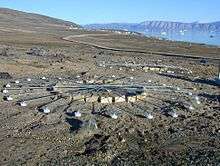
Local government consists of a seven-member council which is elected every four years and which meets four to six times a year. The town is part of the region of Qaasuitsup, which is represented by a council and mayor.
CTBTO Station
Qaanaaq is home to a remote CTBTO infrasound listening station called IS-18, which uses an array of barometric sensors to detect possible nuclear tests around the world.[7][8] The station is maintained by the Danish Meteorological Institute, and as of 2016 the current operator is Svend Erik Ascanius.[7]
Population
With 656 inhabitants as of 2013, Qaanaaq is the largest settlement in the far north of the country.[1] Its population has been relatively stable with only minor fluctuations since the mid-1990s.[9]

The city, with its relatively low population and tradition of hunting, currently has more huskies than human residents.[7]
Climate
Qaanaaq has a polar climate (Köppen "Polar tundra"), and hence it has long, cold winters. Peak temperatures occur in July and seldom exceed 10 °C.
| Climate data for Qaanaaq | |||||||||||||
|---|---|---|---|---|---|---|---|---|---|---|---|---|---|
| Month | Jan | Feb | Mar | Apr | May | Jun | Jul | Aug | Sep | Oct | Nov | Dec | Year |
| Record high °C (°F) | 5 (41) |
1 (34) |
2 (36) |
6 (43) |
12 (54) |
20 (68) |
19 (66) |
17 (63) |
10 (50) |
5 (41) |
3 (37) |
3 (37) |
20 (68) |
| Average high °C (°F) | −19.0 (−2.2) |
−20.6 (−5.1) |
−20.1 (−4.2) |
−12.8 (9) |
−2.6 (27.3) |
4.2 (39.6) |
7.4 (45.3) |
6.2 (43.2) |
0.6 (33.1) |
−6.7 (19.9) |
−12.9 (8.8) |
−17.8 (0) |
−7.8 (18) |
| Daily mean °C (°F) | −23.3 (−9.9) |
−24.6 (−12.3) |
−24.1 (−11.4) |
−17.0 (1.4) |
−5.6 (21.9) |
1.5 (34.7) |
4.6 (40.3) |
3.8 (38.8) |
−1.7 (28.9) |
−9.8 (14.4) |
−16.6 (2.1) |
−21.6 (−6.9) |
−11.2 (11.8) |
| Average low °C (°F) | −27.0 (−16.6) |
−28.4 (−19.1) |
−27.8 (−18) |
−21.0 (−5.8) |
−8.6 (16.5) |
−0.7 (30.7) |
2.1 (35.8) |
1.6 (34.9) |
−4.0 (24.8) |
−12.8 (9) |
−20.1 (−4.2) |
−25.0 (−13) |
−14.3 (6.3) |
| Record low °C (°F) | −40 (−40) |
−58 (−72) |
−41 (−42) |
−34 (−29) |
−22 (−8) |
−7 (19) |
−3 (27) |
−6 (21) |
−17 (1) |
−31 (−24) |
−33 (−27) |
−46 (−51) |
−58 (−72) |
| Average precipitation mm (inches) | 6 (0.24) |
6 (0.24) |
4 (0.16) |
6 (0.24) |
7 (0.28) |
7 (0.28) |
16 (0.63) |
24 (0.94) |
18 (0.71) |
12 (0.47) |
10 (0.39) |
8 (0.31) |
124 (4.88) |
| Average precipitation days (≥ 1.0 mm) | 2 | 2 | 1 | 2 | 2 | 2 | 4 | 4 | 4 | 3 | 3 | 2 | 31 |
| Average relative humidity (%) | 64 | 63 | 63 | 62 | 63 | 69 | 71 | 72 | 69 | 69 | 66 | 67 | 67 |
| Mean monthly sunshine hours | 0 | 8 | 150 | 251 | 316 | 273 | 271 | 175 | 155 | 49 | 0 | 0 | 1,648 |
| Source #1: NOAA[10][11] | |||||||||||||
| Source #2: BBC Weather[12] | |||||||||||||
References
- 1 2 3 Greenland in Figures 2013 (PDF). Statistics Greenland. ISBN 978-87-986787-7-9. ISSN 1602-5709. Retrieved 6 September 2013.
- ↑ http://www.airgreenland.com/
- ↑ Fortescue, Michael. Language Relations Across Bering Strait: Reappraising the Archaeological and Linguistic Evidence. Open Linguistic Press, Cassell, 1998. ISBN 0-304-70330-3
- ↑ "Booking system". Air Greenland. Retrieved 9 June 2010.
- ↑ Practical info - The Official Tourism Site of Greenland
- ↑ Qaanaaq, Greenland
- 1 2 3 4 "IS18, Qaanaaq, Greenland, Denmark: CTBTO Preparatory Commission". www.ctbto.org. Retrieved 2016-09-19.
- ↑ Scott, Tom (September 12, 2016). "Listening for Nuclear Tests at the Top of the World". YouTube. Retrieved September 20, 2016.
- 1 2 Statistics Greenland, Population in localities
- ↑ "Thule Air Base Climate Normals 1961-1990". National Oceanic and Atmospheric Administration. Retrieved February 14, 2013.
- ↑ "Thule Climate Normals 1961-1990". National Oceanic and Atmospheric Administration. Retrieved February 14, 2013.
- ↑ . Retrieved 23 December 2011.
Further reading
- Murray, Louise. 2006. "On Thin Ice – Louise Murray Travels to Qaanaaq in Northern Greenland to See the Effect That Climate Change Is Having on Subsistence Hunters and Their Prey". Geographical : the Royal Geographical Society Magazine. 32.
- Remie, C. H. W. Facing the Future Inughuit Youth of Qaanaaq : Report of the 1998 University of Nijmegen Student Expedition to Qaanaaq, Thule District, Northern Greenland. Nijmegen: Nijmegen University Press, 1999. ISBN 90-5710-078-9
External links
| Wikimedia Commons has media related to Qaanaaq. |
- Page with information on Qaanaaq and surroundings
- The Most Northern Place - A transmedia webdoc about the untold story of Thule
